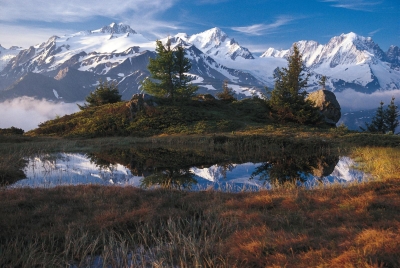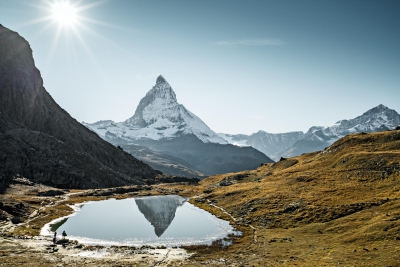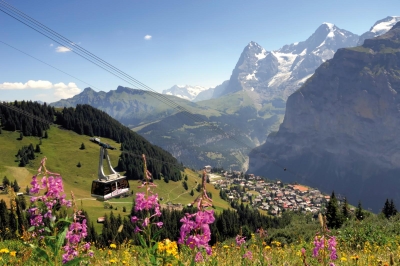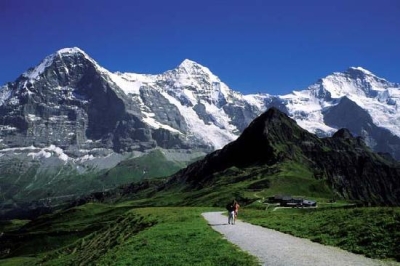- Trips
- Tour Calendar
- About Our Tours
- Plan a Trip
- Book a Trip
- About Us
- Contact Us


The Alps is the best supported hiking and trekking destination in the world. It offers dazzling mountain scenery, hundreds of glaciers, abundant waterfalls, comfortable accommodations, superb cuisine—and it’s all so accessible by trains, trams, funiculars, and a network of well-marked mountain trails. Within this hiker’s heaven, there are four classic alpine treks that are absolute standouts. These treks are defined by high alpine trails and passes that have been used for hundreds of years—and some for thousands of years.
Here are the must-do, bucket list, unforgettable treks in the Alps:

The Tour du Mont Blanc is the classic trek around the Mont Blanc massif. The centerpiece is western Europe’s highest peak—Mont Blanc—but that’s just the start. There are dozens of other dramatic peaks and spires in the Mont Blanc range to amaze you, along with the glaciers, streams, and valleys which flank its slopes. Your route takes you from France through Italy and Switzerland, and then back to France.
Itinerary Overview: Alpenwild’s 12-day Tour du Mont Blanc trek starts in Chamonix and includes stays in Les Contamines, Ville des Glaciers, Courmayeur (2-nights), Val Feret, Champex-Lac, Argentiere, and concludes in Chamonix (2-nights). This is the most luxurious TMB on the market, and is fully supported with nightly luggage transfers and shuttles to and from most trailheads. All accommodations have private rooms with en suite bathrooms. Seven nights in 4-star hotels, three nights in 3-star hotels, and one night in a simple mountain inn.
Route Basics: Starting in or near Chamonix most hikers do the circumambulation of the Mont Blanc Range in a counter-clockwise direction. Traditional stages include Les Contamines, Les Chapieux, Courmayeur, Val Ferret, La Fouly, Champex, Trient, and Argentiere, before arriving in Chamonix.
Highlights: The Aguille du Midi, the world’s highest vertical ascent cable car, takes you to a 12,600-ft overview of the Mont Blanc range. On our rest day in Courmayeur, we take the Monte Bianco Skyway from Courmayeur.
Season: Mid-June to late September

The Haute Route is really a network of trails connecting Chamonix, at the base of Mont Blanc, with Zermatt, at the base of the Matterhorn. Each day is defined by ascending historic and challenging mountain passes. As you pass within view of the highest peaks in the Alps, you’re treated to daily glaciers, alpine lakes, fir forests, and mountain streams. Each night you descend into villages with comfortable accommodations.
Two options—Classic and Deluxe
On Alpenwild's Chamonix-Zermatt Haute Route there are two hut nights in clean, comfortable mountain huts with family-style dining, shared bathrooms, and dormitory accomodations. They offer remote mountain settings, so you won't have luggage for those two nights.
Alpenwild's Deluxe Haute Route bypasses the two huts and adds a rest day in St. Luc at the historic Hotel Bella Tola. You'll have your luggage every night. We've also include two spa treatments as part of the tour—one in St. Luc, and one in Zermatt.
Route Basics: The Haute Route offers more route options and flexibility than the TMB but typically you’ll be staring in Chamonix with stages to Trient, Champex, and Verbier, followed by hut nights in Louvie and Prafleuri. Then it’s on to Arolla, La Sage, Grimentz, Zinal (or St Luc), Gruben, and on to Zermatt. With the completion of the new suspension bridge on the Europaweg between Grächen and Zermatt, this is extension is once again a viable option. But for most hikers, by the time you get to St. Niklaus you’ll be eager to experience the great dayhike options that abound in Zermatt.
Highlights: With Chamonix and Mont Blanc on one end and Zermatt and the Matterhorn on the other, it’s hard to pick favorites. And what lies in between includes the highest peaks of the Alps, with standouts like the Grand Combin, the Weisshorn, and the Dent Blanche. Charming villages like Champex, Arolla, Grimentz, and St Luc dot the way.
Season: Early July to late September

This landscape was made for hikers looking to access many of the most challenging mountain ascents in the Bernese Alps. So the approaches and passes aren’t age-old and gently-graded trade routes, but challenging and direct mountain trails. There are options, alternative routes, and lots of spurs and side hikes to enjoy. Each of the traditional stops along the way features dayhikes in every direction. Towns like Mürren, Kandersteg, and Adelboden are hard to pass through briefly—They beg you to linger and explore.
Route Basics: The route doesn’t stray far from the classic Via Alpina, although it features some thoughtful enhancements and rest days. Alpenwild trek starts in Murren, then goes over the Sefinenfurgge to Griesalp and on to Kandersteg via the Hohtürli. Then it’s on to Adelboden and Lenk before concluding in Gstaad—which is fitting since this star-struck farming village marks the western edge of the Bernese Alps.
Highlights: On a recent July outing we observed that there isn’t a moment on the entire trek when you aren’t in view of a waterfall—many among the largest and highest in Switzerland. The lakes and wildflowered alpine meadows also delight. This trek shines in the early season.
Season: Early July to late September
Long, deep valleys, classic alpine passess, lakes, and waterfalls make this a favorite hiking area for the Swiss. But it's not as well known to North American hikers. That puts it off the tourist trail and more authentically Swiss. This is William Tell Country and the heart of the Old Swiss Confederation with lots of tradition and history,
Route Basics: The route is true to the classic Via Alpina 1, the national route through Switzerland. The Via Alpina, also known as the Alpine Pass Route starts in Sargans, then slices through the Glarus and Uri Alps on it's way. through Eastern nad Central Switzerland.
Highlights: This route starts great and seems to get better with every step. The stage from Engstlenalp to Meiringen along the Erzegg to Planplatten ridge with commanding views in all directions, including many of the giants of the Bernese Alps
Season: Early July to late September

This trek connects the two icons of the Swiss Alps—the fearsome Eiger with its towering North Face and the awe-inspiring Matterhorn. In discovering these two legendary peaks, you’ll also take in the best of both the Bernese and the Pennine Alps. This is a historic trek that hinges on the Gemmi Pass, a route with Roman roots, which became the primary trade route in the 18th and 19th century, connecting Bern with the Rhone Valley before railway service. This trek includes everything a classic trek should include—glaciers (the two largest in the Alps), dozens of 4000-meter peaks, challenging passes, and charming villages.
Route Basics: Start in Grindelwald at the base of the North Face of the Eiger, where you’ll witness the various climbing routes which ascend through 5000 feet of vertical rock and ice to the summit. A tunnel through the Eiger concludes at the Jungfraujoch which overlooks the Aletsch Glacier, the longest in the Alps. Crossing over the Kleine Scheidegg into the Lauterbrunnen Valley you’ll continue on to stay in Murren, Griesalp, and Kandersteg. Crossing the Gemmi Pass we stay in Leukerbad, the largest spa and wellness resort in the Alps. On our way to Zermatt we cross the world’s longest suspension bridge. Arriving in Zermatt, we enjoy some of the great hikes and mountain excursions in the area including the Gornergrat.
Highlights: Just the Eiger or just the Matterhorn would be stand-alone highlights on any other trip. But to capture them both in one trek is unforgettable. And that’s just the beginning. There’s the Lauterbrunnen Valley with its waterfalls, Öeschinensee, Kandersteg, the Gemmi Pass descent into Leukerbad, and the crossing of the Europabrücke, the longest pedestrian suspension bridge in the world.
Season: Early July to late September